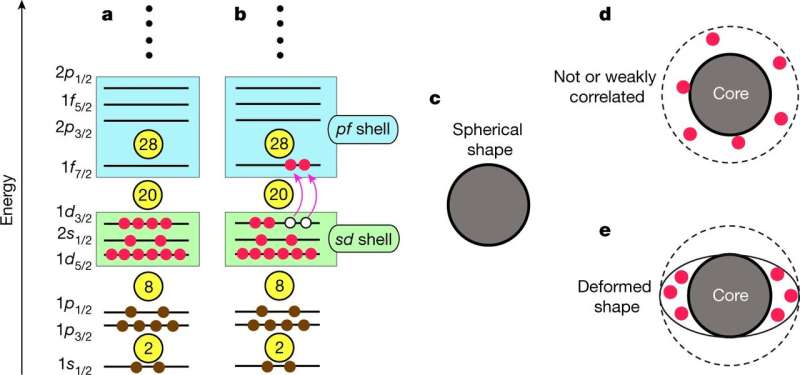Schematic illustrations of shell structure and nuclear shape. Credit: Nature (2020). DOI: 10.1038/s41586-020-2848-x
A team of physicists affiliated with several institutions in Japan and one in Belgium has theorized that one of the mechanisms responsible for the neutron drip line is related to deformation. In their paper published in the journal Nature, the group describes their calculations regarding the contributions to binding energy for deformations in nuclei as part of an effort to better understand how many neutrons an atom can hold.
One area of interest to physicists and chemists is how many neutrons can be held by one atom. The boundary expressed by such an arrangement is called the drip line. It comes about because energy is used to pull nuclei apart, thus there must always be a limit. In some instances, atoms have been tested (sometimes resulting in the creation of interesting isotopes), but many others have not, and thus, their boundaries are not known. In this new effort, the researchers sought a mechanism that governs driplines in general that might allow for mathematically calculating the answer for any given element under any given circumstance.
To explore this possibility, the researchers chose fluorine as their baseline. They used math to show that its dripline could be predicted by using a previously untried mechanism. They found that as the number of neutrons grows, the nuclear shape of the nucleus becomes deformed into an ellipsoid, which leads to higher binding energy. They further found that the saturation point of the nucleus (the point where it could no longer be deformed) gave the neutron drip line. They noted that beyond such a saturation point, the isotope became unbound, allowing more neutrons to drip out.
The researchers note that their calculations were based on recently discovered nuclear-nucleon interactions that have been used in eigenvalue solving simulations. They further note that their results showed a reasonable amount of agreement with recent experiments conducted by other researchers. They suggest that their work could be used in further efforts by other groups seeking to better understand nucleosynthesis when neutron-rich nuclei are involved.
More information: Naofumi Tsunoda et al. The impact of nuclear shape on the emergence of the neutron dripline, Nature (2020). DOI: 10.1038/s41586-020-2848-x
Journal information: Nature
© 2020 Science X Network
























